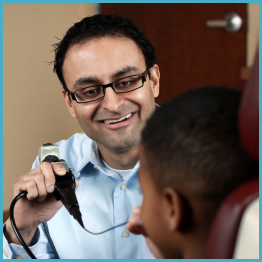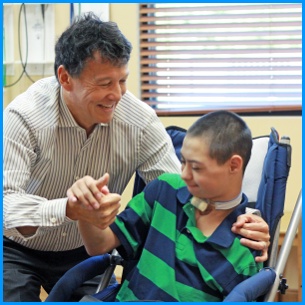- Laryngoscopy
- Bronchoscopy
- Tracheostomy
- Balloon Dilation
- Minimally Invasive Surgery (Endoscopic Surgery)
- Laryngotracheal reconstruction (LTR)
- Tracheocutaneous Fistula Closure

Airway anomalies in children can be either congenital (your child was born with it) or acquired (your child has it from another cause). Evaluation and treatment of airway anomalies in children is best done by an experienced, well-trained pediatric ENT surgeon. After a thorough diagnosis and workup of an airway problem, your ENT for Children surgeon may recommend different airway procedures. The goal of surgery is different in every child. The most important goal is always to have a safe, stable airway. Other factors involved in surgery include feeding, swallowing and the voice. There are numerous reasons for airway problems in children, all with different methods of treatment. Your pediatric ENT specialist may discuss surgery for the following problems:
- Airway obstruction causing noisy breathing or breathing difficulty.
- Children with tracheostomy tubes for airway obstruction or long term need for ventilation.
- Children who suffer from trachea or larynxstenosis (narrowing).
- Children who suffer from certain conditions such as: laryngeal web, laryngeal cleft, laryngeal papillomas, laryngomalacia (floppy weakness of the voice box tissue), obstructive sleep apnea, chronic aspiration and vocal cord paralysis among others.
Due to the critical nature of a child’s airway, all of the anesthesiologists we work with are specially trained, board certified, pediatric anesthesiologists with years of experience doing airway surgery. A few of the more common airway procedures are listed below:
Laryngoscopy
This is a procedure to look at your child’s larynx (voice box) in more detail. This is often done in the office with a fine flexible camera placed through the nose. When more detail is required or other procedures need to be performed, the laryngoscopy is done through the mouth in the operating room under anesthesia with special scopes and cameras. Additional procedures on the voice box and airway can be performed via this route. This is the preferred way to treat laryngomalacia, laryngeal papillomas, laryngeal webs and laryngeal clefts.
Bronchoscopy

A bronchoscopy is a procedure done in the operating room under anesthesia to look down into the main windpipes going toward the lungs. This is done through the mouth in conjunction with a laryngoscopy. A bronchoscopy may be recommended to help diagnose and/or treat various problems such as airway stenosis, noisy breathing, aspiration of a foreign body, or tracheomalacia (floppy weakness of the windpipe). A bronchoscopy may also be required at interval periods if there is a tracheostomy tube in place.
Tracheostomy
Severe airway obstruction, long term need for a ventilator or problems with chronic aspiration may require your child to have a tracheostomy tube placed. This is a procedure done under anesthesia and entails an artificial breathing tube placed into the windpipe through the neck. This tube allows a clear pathway for breathing. It also allows a ventilator to be used long term outside the hospital. In cases of chronic aspiration, it also allows the secretions to be suctioned from the windpipe to prevent infections and pneumonias. The length of time a tracheostomy tube is needed varies tremendously and is based on many factors. If a tracheostomy tube may be necessary for your child, your ENT for Children surgeon will discuss it with you in more detail.
Balloon Dilation

Children with a stenosis of the airway may be able to have the area opened with a balloon. This is a procedure done under anesthesia that uses a special balloon to dilate (widen) your child’s airway. This procedure is done in conjunction with a laryngoscopy and bronchoscopy.
During the procedure your pediatric ENT surgeon will place the balloon through the mouth into the area of the stenosis and inflate it to stretch open the narrowing. Adjunct tools used with this procedure may include using a laser to cut the scar prior to ballooning or medications to prevent the area from re-scarring. The procedure may need to be repeated to keep the area open long term.
Minimally Invasive Surgery (Endoscopic Surgery)
Minimally invasive surgery is a broad term for airway procedures that are done partially or entirely through the mouth to possibly avoid an incision on the outside of the neck. This technique uses special micro-instruments and cameras to perform surgery on the airway through the mouth. This method has the benefit of reduced pain and shorter recovery time. Many different airway procedures can be done in this manner, however some cannot. When possible, we at ENT for Children always try to perform airway procedures endoscopically.
Laryngotracheal reconstruction (LTR)

A laryngotracheal reconstruction is one of the more complex airway surgeries we perform and is usually only done by experienced pediatric ENT surgeons with airway surgery experience. Laryngotracheal reconstruction (LTR), also known as laryngotracheoplasty, is a surgery that is used to correct a child’s narrowed airway. The area of narrowing is often in the area of the vocal cords (glottis) or below the vocal cords (subglottic stenosis). This surgery may be recommended to help remove a tracheostomy tube, to avoid having a tracheostomy tube placed or to improve the airway enough for comfortable, safe breathing.
The procedure is based on splitting open the narrow part of the airway and placing a specially carved piece of cartilage in the gap to widen the airway. The cartilage is harvested from the child’s own body; either from the neck or from the ribcage. Two splits with two pieces of cartilage may be used in severe stenosis. This procedure can be done in various different manners. The entire process may be done at once or staged into 2 separate surgeries using a stent to keep the cartilages in place during healing. In certain situations, we are able to perform the LTR endoscopically (minimally invasive). After surgery, children need to stay in the Pediatric Intensive Care Unit during the healing process. Follow up laryngoscopies and bronchoscopies are common to ensure that the airway heals well and stays open.
Tracheocutaneous Fistula Closure
A Tracheo-cutaneous fistula is a condition that can occur after removal of a tracheostomy tube. This is where a small hole remains open in the neck where the tracheostomy tube was removed. This small opening can leak mucous and air from the windpipe. Your ENT for Children specialist may observe the fistula to see if it will close on its own. If the tracheo-cutaneous fistula does not close then it will need to be surgically closed.
The procedure is done under anesthesia, usually in conjunction with a laryngoscopy and bronchoscopy. An incision is made over the fistula and old tracheostomy tube scar, which are then carefully and cleanly removed. The windpipe, neck muscles and skin are then fully closed with sutures. Children stay in the hospital in the Pediatric Intensive Care Unit after surgery for observation of their breathing. A small drain is left in the neck and usually removed at the bedside upon discharge (usually 1-2 days).
